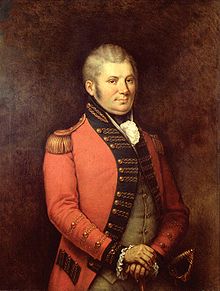John Graves Simcoe
John Graves Simcoe (* 25. February 1752 in Cotterstock , United Kingdom ; † 26. October 1806 in Exeter ) was a British officer and from 1791 to 1796, the first Lieutenant Governor of Upper Canada (Upper Canada), which is about the southern part of the present province of South - Ontario equates.
He founded the city of York , now Toronto , and played an essential role in establishing British institutions in his province, such as: B. the judiciary and the jury trial , also in the abolition of slavery .
Life
Simcoe graduated from Eton and Oxford . In 1770 he joined the British Army . He obtained his officer license in the 35th Infantry Regiment and was transferred to North America to Boston to fight in the American Revolution. Simcoe was one of the most successful commanders during the war and was promoted to lieutenant colonel. He was wounded three times during the course of the war and was eventually captured in 1779. Two years later he returned to the UK.
The "Province of Upper Canada" was founded by the constitutional law of 1791. This law stipulated that the provincial government should consist of the lieutenant governor, an appointed executive council and an elected legislative council. Simcoe was elected lieutenant governor and moved with his wife Elizabeth and daughter Sophia in the same year first to Québec , then in the spring of 1792 to Kingston and then to Newark, today's Niagara-on-the-Lake .
Simcoe tried first to set up a functioning provincial administration. On September 17, 1792, the nine-member legislative council and sixteen-member legislative assembly met in Newark for the first time. Simcoe soon suggested moving the capital away from the dangerous US border and more to the safe center of the peninsula between Lake Erie and Lake Huron . He named the planned location for the new capital London and the river through the city accordingly Thames River (Thames). However, Governor General Guy Carleton, 1st Baron Dorchester disagreed with Simcoe's proposal, but accepted Simcoe's second proposal, Toronto . In 1793 Simcoe moved the capital there and named it York after Frederick , the Duke of York , second son of King George III.
As a former military leader, after the founding of York, Simcoe saw one of his main tasks in connecting the city with various major cities in Upper Canada via military roads. These roads turned out to be groundbreaking for trade and settlement, opening up access to large areas in the southern province of Ontario:
- The Kingston Road led in an easterly direction along the north shore of Lake Ontario for a distance of 260 km to Kingston .
- The Dundas Road led north from Lake Ontario, later west to Hamilton over a similar distance, with a planned continuation to London, Ontario .
- The Yonge Street led from the lake directly in York north to Lake Simcoe (then Lake Toronto) and was extended several times km 1793-1796 up to a distance of 1,200, one of the longest roads in the world.
Simcoe's most important achievement was the limitation of slavery . The Legislative Assembly disagreed with his original plan for complete abolition, but eventually approved his compromise proposal. According to this, no new slaves were allowed to be brought into the province of Upper Canada and that the children of female slaves were released at the age of 25. As a result, slavery in Upper Canada effectively ended in 1810. In 1833, slavery was finally abolished by law on all British property.
In July 1796, his poor health forced Simcoe to return to Britain. In 1798 he officially resigned from his post in Upper Canada. Later he was for a short time Governor of St. Domingo ( Haiti ) and Commander of the Western District in Great Britain. He died on October 26, 1806 and was buried in Wolford Chapel on the family estate in Exeter .
In addition to Lake Simcoe , the city of Simcoe in southwestern Ontario was named after him. There is also Simcoe Day in the province , a day of remembrance in his honor on the first Monday in August.
Simcoe became a member of the Freemasons ' Union in November 1773 , his lodge ( Union Lodge No. 307 ) is based in Exeter .
literature
- Simcoe, John Graves . In: Encyclopædia Britannica . 11th edition. tape 25 : Shuválov - Subliminal Self . London 1911, p. 120 (English, full text [ Wikisource ]).
Film adaptations
In the US historical series Turn: Washington's Spies , which deals with the espionage association Culper Ring under George Washington's command, John Graves Simcoe is portrayed as an unscrupulous and sadistic officer in the Queen's Rangers .
Web links
Individual evidence
- ^ Union Lodge. Minute Book (1766–1789), p. 113.
- ↑ Karen Stanworth: Visibly Canadian: Imaging Collective Identities in the Canadas, 1820-1910. McGill-Queen's University Press, 2014, ISBN 978-0-7735-4458-1 , p. 347.
- ↑ Famous Canadian Freemasons. Eureka Lodge AF & AM, No 283, GRC; Retrieved July 8, 2015
| personal data | |
|---|---|
| SURNAME | Simcoe, John Graves |
| BRIEF DESCRIPTION | British Lieutenant Governor of Upper Canada |
| DATE OF BIRTH | February 25, 1752 |
| PLACE OF BIRTH | Cotterstock , UK |
| DATE OF DEATH | October 26, 1806 |
| Place of death | Exeter |


